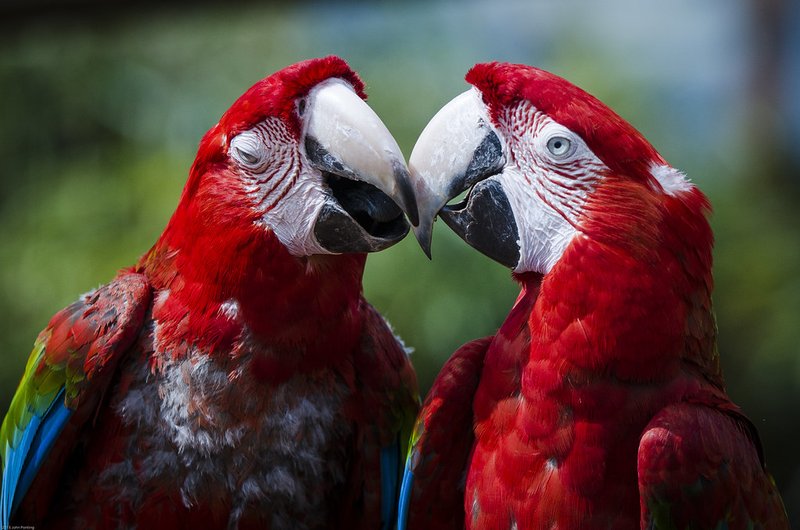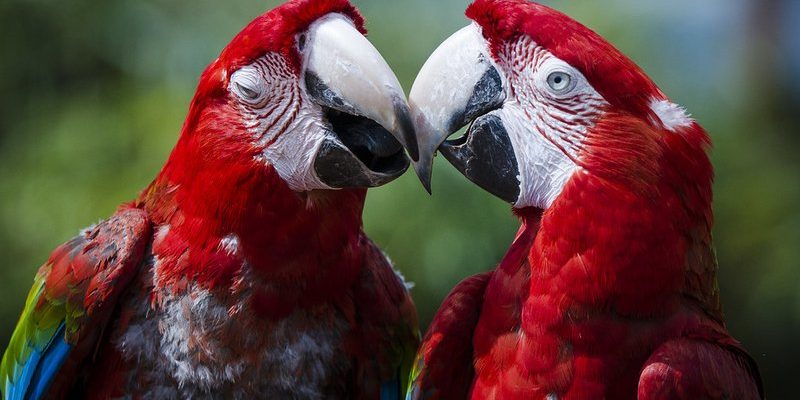
Imagine being in the rainforest, where the sounds of birds fill the air. You’re sipping a hot cup of coffee and suddenly hear the distinct squawking of a scarlet macaw. Their beauty is mesmerizing, but it’s their courtship behaviors that are truly captivating. Let’s dive into these colorful ceremonies that make the scarlet macaw one of nature’s most remarkable lovebirds.
The Basics of Scarlet Macaw Courtship
Scarlet macaws generally form monogamous pairs, which means once they find their mate, they’re in it for the long haul. Courtship rituals start well before the breeding season. During this time, you might witness a couple engaging in elaborate displays that look almost like a dance.
These rituals often include synchronized movements where both birds mirror each other’s actions. This can involve preening, bowing, and even a bit of playful chasing. It’s similar to how humans might go out for dinner and a dance to impress their date. By displaying their agility and beauty, scarlet macaws show off not just for fun, but to strengthen their bond and ensure they’re both ready for a lifelong partnership.
Vocalizations and Communication
One of the most striking aspects of their courtship is their vocalizations. Scarlet macaws are known for their loud calls, which are often used to communicate and attract mates. During courtship, these vocalizations become even more prominent. Males will often call out with a melodic screech, hoping to catch the attention of nearby females.
These calls are not just random noises; they convey information. Here’s the thing: when a male calls, he’s not just saying “Hey, look at me!” He’s also signaling his health and strength. A loud, clear call can indicate a strong, capable mate—something every female wants. The intensity and frequency of these calls often ramp up as the mating season approaches, making it hard to ignore their presence in the jungle.
Visual Displays and Physical Interactions
As mating season draws near, scarlet macaws engage in various visual displays. Males will flaunt their vibrant plumage, puffing up their feathers to appear larger and more attractive. This is crucial, as females are often drawn to the brightest and most beautiful birds, thinking that bright colors signify good health.
You might also notice them engaging in playful behavior, such as chasing each other from branch to branch. This kind of interaction not only strengthens their bond but allows them to gauge each other’s fitness and compatibility. If you’ve ever seen a couple joking and teasing each other, you can imagine how these playful antics work the same way for scarlet macaws. It’s about creating a connection, building trust, and ensuring that both parties are ready for the commitment of raising offspring together.
Nesting and Pair Bonding
Once a pair has established a strong bond, they start looking for a nesting site. Scarlet macaws prefer to nest in tree cavities, which provide a safe space for their future chicks. The female typically lays two to four eggs, and both parents take turns incubating them. This commitment to parenting reinforces their bond even further.
During this nesting phase, you’ll see the pair maintaining close proximity to each other. They engage in mutual preening, which is a way to reinforce their connection. Much like how couples share intimate moments, these acts of grooming not only keep their feathers in top shape but also serve as reassurance of their partnership.
Why Courtship Matters in Scarlet Macaws
You might be wondering why these intricate courtship rituals are so important. The courtship and mating rituals of scarlet macaws play a crucial role in species survival. By selecting strong mates through these displays, both males and females increase the likelihood of producing healthy offspring.
Also, having strong pair bonds ensures that both parents are present during the rearing of chicks, which enhances their survival rates. It’s pretty much nature’s way of ensuring that the best genes are passed on while also looking out for the next generation.
The Role of Environment
The surrounding environment can influence these rituals significantly. Scarlet macaws rely heavily on their habitat for food and nesting sites, so any changes in the environment can affect their courtship behaviors. Deforestation and habitat loss can disrupt their rituals and impact their overall reproductive success.
In many ways, it’s a delicate balance. Just as our relationships are influenced by our surroundings, the courtship and mating rituals of these stunning birds are shaped by the health and stability of their environment. Preserving their habitats is incredibly important, and understanding their mating behavior can help raise awareness about their conservation needs.
Challenges in Courtship and Mating
While scarlet macaws have beautiful courtship rituals, they also face challenges. Their vibrant plumage, which is so essential for attracting mates, can also make them more visible to predators. Additionally, environmental issues like habitat destruction and climate change put pressure on these birds and their breeding success.
Another challenge comes from human interference, such as illegal trapping and trade. This not only reduces their populations but can also disrupt their natural mating patterns. The loss of mate selection can lead to genetic bottlenecks, preventing healthy diversity in their gene pool.
It’s vital to recognize these challenges if we want to protect the future of scarlet macaws. Conservation efforts that safeguard their habitats and educate the public about their importance can help mitigate some of these risks.
Conservation Efforts and Future Outlook
Understanding the courtship and mating rituals of scarlet macaws highlights the need for strong conservation policies. Organizations and local communities are working hard to protect their habitats and ensure that future generations can witness their stunning displays of love.
Efforts like reforestation, creating protected areas, and enforcing laws against illegal trapping are just a few ways we can support these magnificent creatures. As individuals, we can also contribute—whether through donations, volunteering, or spreading the word about the importance of preserving wildlife.
By putting in the effort now to understand and protect scarlet macaws, we can help ensure that their vibrant courtship rituals continue for generations to come.
Wrapping It Up
The courtship and mating rituals of the scarlet macaw are not only a celebration of love but also a vital part of their survival as a species. From vocalizations to visual displays and the challenges they face, there’s a lot to learn about how these beautiful birds find their mates and raise their young.
By understanding their behaviors, we can appreciate how important it is to protect their habitats and ensure their survival. Let’s celebrate these vibrant creatures and do our part to keep their love stories alive in the wild.

